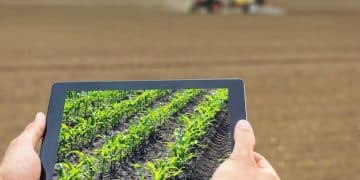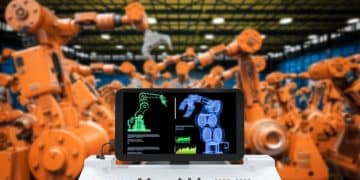Startup Spotlight: Logistics Tech – Optimizing Delivery Routes and Supply Chain Efficiency for US Businesses
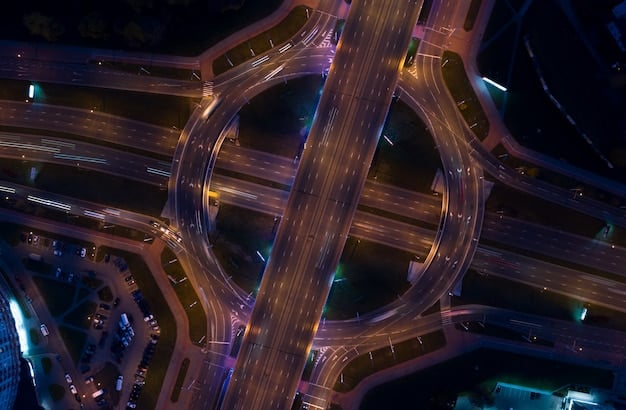
Startup Spotlight: Logistics Tech – Optimizing Delivery Routes and Supply Chain Efficiency for US Businesses showcases how emerging technology companies are revolutionizing the American logistics sector, enhancing everything from last-mile delivery to complex supply chain networks through advanced software and automation solutions.
The intricate dance of goods and services across the vast landscape of the United States hinges significantly on effective logistics. As businesses strive for unprecedented levels of speed, precision, and cost-efficiency, the spotlight inevitably turns to innovations within the sector. This article delves into a crucial area: Startup Spotlight: Logistics Tech – Optimizing Delivery Routes and Supply Chain Efficiency for US Businesses, exploring how new ventures are leveraging technology to reshape the backbone of commerce.
The Evolution of US Logistics: From Manual to Digital
The American logistics landscape has historically been characterized by its sheer scale and complexity. For decades, route planning, inventory management, and freight coordination relied heavily on manual processes, often leading to inefficiencies, delays, and significant operational costs. This traditional model, while functional, presented numerous bottlenecks as consumer demands for faster, cheaper, and more transparent deliveries intensified. The rise of e-commerce, in particular, exerted immense pressure on businesses to rethink their logistical strategies, compelling them to seek more agile and responsive solutions.
This shift paved the way for the burgeoning field of logistics technology, or “logistics tech.” This isn’t merely about incremental improvements; it represents a fundamental paradigm shift. Companies are moving from reactive problem-solving to proactive optimization, driven by data, automation, and intelligent algorithms. The digitalization of logistics processes promises not only to streamline existing operations but also to unlock entirely new possibilities for efficiency, sustainability, and customer satisfaction. It’s a journey from analog limitations to digital liberation, redefining how goods move from origin to destination across the country.
Historical Inefficiencies and the Need for Change
Historically, logistics operations in the US faced several core challenges that limited efficiency:
- Manual Route Planning: Often based on experience rather than real-time data, leading to longer routes and higher fuel consumption.
- Lack of Visibility: Limited real-time tracking of shipments, making it difficult to anticipate delays or adjust routes.
- Inventory Mismanagement: Inaccurate stock levels resulting in overstocking or stockouts, impacting capital and customer fulfillment.
The pressure to adapt became undeniable. Businesses, from small local shops to large multinational corporations, recognized that outdated logistics practices were no longer sustainable in a rapidly evolving market. The realization that technology could provide a competitive edge fueled investment and innovation in the logistics tech sector, setting the stage for the wave of startups we see today. The aspiration was clear: transform the intricate web of supply chains into a finely tuned, data-driven ecosystem where every movement is optimized for maximal impact and minimal waste.
This transformative period is defined by a rigorous pursuit of optimization, where every element of the supply chain is analyzed and re-engineered for peak performance. Technology serves as the catalyst, enabling companies to achieve levels of efficiency and responsiveness previously unimaginable. The transition from legacy systems to modern, integrated platforms is not just an upgrade; it’s a strategic imperative that underpins the future success of businesses in the US and beyond.
Route Optimization Startups: Navigating the Last Mile Challenge
The “last mile” of delivery, the final leg from a transportation hub to the customer’s doorstep, is notoriously the most complex and expensive part of the supply chain. It accounts for a significant portion of total delivery costs and is often where customer satisfaction is won or lost. Recognizing this critical bottleneck, a wave of innovative startups has emerged, focusing specifically on optimizing delivery routes through advanced algorithms and real-time data analysis. These companies are not just providing mapping services; they are building sophisticated platforms that can digest vast amounts of information—traffic patterns, weather conditions, delivery windows, vehicle capacity, and even customer preferences—to craft the most efficient routes possible.
The impact of these solutions is profound. By minimizing travel distance and time, route optimization technologies dramatically reduce fuel consumption, lower operational expenses, and decrease the carbon footprint of delivery fleets. Moreover, they enable businesses to increase the number of deliveries per shift, improving overall productivity and ensuring timely arrivals. This enhanced efficiency directly translates to a better customer experience, with predictable delivery times and fewer missed appointments. These startups are essentially transforming the chaotic nature of urban and rural deliveries into a streamlined, predictable, and highly efficient operation, ensuring that every driver’s journey is as effective as possible.
Key Innovations in Last-Mile Delivery
Startups in this space are leveraging a combination of cutting-edge technologies:
- AI and Machine Learning: To predict optimal routes, adjust to real-time changes, and learn from past delivery data.
- GPS and Telematics Integration: Providing precise location tracking and vehicle performance data for continuous improvement.
- Dynamic Route Adjustment: Allowing for immediate rerouting in response to unexpected obstacles like road closures or sudden surges in orders.
These functionalities empower logistics managers with unprecedented control and insight over their delivery operations. What was once a static, pre-planned route can now adjust on the fly, ensuring maximum adaptability in the face of unforeseen circumstances. This responsiveness is vital in an era where customer expectations for rapid and reliable delivery are higher than ever. The innovation extends beyond mere pathfinding, encompassing predictive analytics to anticipate common issues and proactively suggest solutions, thereby mitigating potential disruptions before they even occur.
The cumulative effect of these innovations is a significant uplift in overall operational efficiency and a tangible improvement in service quality. By mastering the last mile, these logistics tech startups are not only saving businesses money but are also helping them build stronger, more reliable relationships with their customers. Furthermore, the data collected from these optimized routes provides invaluable insights for future planning, creating a continuous loop of improvement that reinforces the efficacy of their systems over time, further solidifying their competitive advantage.
Enhancing Supply Chain Visibility and Efficiency
Beyond route optimization, logistics tech startups are making significant strides in enhancing overall supply chain visibility and efficiency. Traditional supply chains often suffer from a lack of transparency, where goods can become “lost” or delayed without immediate notice, leading to cascading problems throughout the network. New platforms are addressing this by integrating data from various points in the supply chain – from raw material sourcing and manufacturing to warehousing and final delivery – into a single, cohesive view. This comprehensive visibility allows businesses to monitor their inventory in real-time, track the progress of shipments across continents, and identify potential disruptions before they escalate into major issues.
The benefits of such enhanced visibility are multifaceted. Businesses can reduce holding costs by precisely managing inventory levels, avoiding both overstocking and stockouts. They can also improve their responsiveness to market changes, quickly rerouting shipments or adjusting production schedules based on accurate, up-to-the-minute information. Furthermore, increased transparency fosters greater accountability among supply chain partners, leading to more collaborative and efficient operations. By providing a holistic, real-time snapshot of the entire supply chain, these startups are empowering companies to make more informed decisions, optimize resource allocation, and ultimately build more resilient and agile supply networks capable of navigating the complexities of the modern global economy.
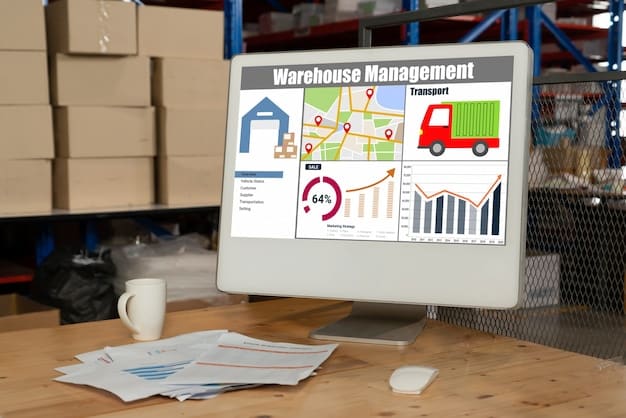
Technologies Driving Supply Chain Transformation
Key technologies at the forefront of this transformation include:
- IoT (Internet of Things): Sensors on vehicles, containers, and products provide real-time data on location, condition, and environment.
- Blockchain: Offering an immutable ledger for tracking goods and transactions, enhancing trust and transparency across multiple parties.
- Cloud-Based Platforms: Facilitating seamless data sharing and collaboration among disparate supply chain entities.
These technologies converge to create an interconnected data ecosystem, where insights are readily available and actionable. The precision afforded by IoT sensors allows for micro-level tracking, enabling proactive intervention should conditions deviate from optimal. Blockchain’s decentralized nature ensures the integrity of records, crucial for managing complex international supply chains and ensuring compliance. Meanwhile, cloud platforms serve as the connective tissue, enabling disparate systems and partners to communicate effectively and share vital information without friction, dismantling traditional data silos that hindered operational fluidity.
The strategic implementation of these advanced tools results in a supply chain that is not merely efficient but intelligently adaptive. Businesses can transition from reactive troubleshooting to predictive maintenance and anomaly detection, significantly reducing costs associated with delays and disruptions. Ultimately, these innovations are paving the way for a supply chain that is not only highly efficient but also intrinsically robust, capable of weathering unforeseen challenges and capitalizing on new opportunities with unparalleled speed and accuracy.
Automation and Robotics in Logistics Warehouses
The modern logistics warehouse is rapidly evolving from a manual labor-intensive facility into a high-tech hub powered by automation and robotics. Startups in this space are developing sophisticated solutions that automate tasks traditionally performed by humans, from picking and packing merchandise to sorting and transporting goods within the warehouse. These innovations include autonomous mobile robots (AMRs) that navigate warehouse floors, robotic arms capable of handling diverse products, and automated storage and retrieval systems (AS/RS) that optimize space utilization. The motivation behind this shift is clear:
The Advantages of Automation
- Increased Speed and Throughput: Robots can operate 24/7 without fatigue, significantly accelerating processing times.
- Reduced Labor Costs: While initial investment can be high, automation leads to long-term savings on wages and benefits.
- Enhanced Accuracy: Automated systems minimize human error in picking and sorting, leading to fewer mis-shipments.
- Improved Safety: Robots can handle heavy lifting and repetitive tasks, reducing the risk of workplace injuries for human employees.
Furthermore, these systems offer unparalleled scalability and flexibility. As demand fluctuates, automated warehouses can adapt quickly, scaling operations up or down without the hiring and training complexities associated with human labor. This agility is crucial for businesses operating in dynamic markets, allowing them to remain competitive and responsive to rapid changes in consumer behavior. The integration of artificial intelligence further refines these systems, enabling robots to learn from their environment, optimize their movements, and even anticipate maintenance needs, leading to predictive upkeep rather than reactive repairs, enhancing overall uptime and efficiency.
The synergy between humans and robots in these facilities is also a key area of focus. Rather than replacing human workers entirely, many logistics tech solutions aim to augment their capabilities, freeing them from repetitive tasks so they can focus on more complex, value-added activities. This collaborative approach fosters a safer, more productive, and more intellectually stimulating work environment, redefining the roles of human employees in the automated warehouse. These advancements are not just about doing things faster; they are about doing them smarter, creating a more resilient and adaptable logistics infrastructure that is ready for the challenges of tomorrow.
Data Analytics and Predictive Modeling for Supply Chains
In the complex ecosystem of modern supply chains, data is the new oil. Logistics tech startups are increasingly leveraging advanced data analytics and predictive modeling to offer businesses unprecedented insights into their operations. This goes far beyond simply tracking current shipments; it involves analyzing historical data, real-time feeds, and external factors (like economic indicators or geopolitical events) to forecast future demand, anticipate potential disruptions, and optimize strategic decisions. By applying sophisticated statistical models and machine learning algorithms, these platforms can identify patterns, uncover hidden inefficiencies, and predict outcomes with a high degree of accuracy.
For businesses, the power of predictive analytics means moving from a reactive stance to a proactive one. Instead of responding to supply chain problems after they occur, they can anticipate them and implement preventative measures. This includes optimizing inventory levels to meet future demand without waste, identifying ideal times for replenishing stock, predicting equipment failures before they happen, and even forecasting the impact of new regulations on logistics costs. The ability to peer into the future with greater clarity allows for more agile planning, better resource allocation, and ultimately, a more resilient and cost-effective supply chain. It’s about turning raw data into actionable intelligence that drives strategic advantage.
Impact of Predictive Analytics on Logistics Operations
The transformative effects of predictive analytics are evident across several areas:
- Demand Forecasting: More accurate predictions reduce the risk of overstocking and stockouts, optimizing inventory holding costs.
- Risk Mitigation: Identifying potential disruptions (e.g., port congestion, extreme weather) allows for proactive rerouting or alternative sourcing.
- Fleet Maintenance: Predicting when vehicle components are likely to fail enables scheduled maintenance, avoiding costly breakdowns.
- Pricing Optimization: Dynamically adjusting shipping costs based on predicted demand and capacity.
This level of insight empowers a completely new dimension of operational control. Businesses can fine-tune their entire logistics strategy, from the initial procurement of raw materials to the final delivery of finished goods. Predictive models help in making granular adjustments to operational plans, ensuring that resources are utilized optimally and that potential vulnerabilities are addressed before they manifest into significant issues. The result is a leaner, more responsive, and more robust supply chain, equipped to handle market volatility and unforeseen challenges with greater confidence and efficiency.
Furthermore, predictive analytics facilitates better strategic planning for long-term growth and expansion. By understanding future trends and potential disruptions, companies can make informed decisions about infrastructure investments, partnership selections, and technology adoption. This foresight translates into sustainable competitive advantages, allowing businesses to not only meet but exceed evolving customer expectations. The ability to predict and adapt is no longer a luxury but a necessity, and these logistics tech startups are providing the foundational tools to achieve it.
Sustainability and Green Logistics Tech Solutions
As environmental concerns become increasingly central to business operations, logistics tech startups are playing a pivotal role in driving sustainability within supply chains. “Green logistics” is no longer just a buzzword; it’s a critical imperative for modern enterprises, driven by consumer demand, regulatory pressures, and a genuine commitment to reducing environmental impact. These innovative companies are developing solutions that help businesses minimize their carbon footprint, optimize resource consumption, and adopt more eco-friendly practices across their logistics operations. Their approaches range from sophisticated route optimization that reduces fuel usage to platforms that facilitate the adoption of electric vehicles and sustainable packaging.
The focus is on creating a more ecologically responsible supply chain without compromising efficiency or profitability. For instance, advanced route planners consider not only the shortest path but also the most fuel-efficient one, often integrating data on vehicle emissions. Other solutions promote the use of alternative fuels, optimize warehouse energy consumption through smart systems, or incentivize the return and reuse of packaging materials. The goal is to build a logistics network that is not only economically viable but also environmentally sound, contributing positively to the planet while still delivering goods effectively.
Key Areas of Green Logistics Tech Innovation
- Optimized Routing for Emissions Reduction: Algorithms prioritize routes that minimize fuel consumption and, consequently, carbon emissions.
- Fleet Electrification Tools: Platforms that help businesses plan and manage the transition to electric vehicles, including charging infrastructure optimization.
- Sustainable Packaging Solutions: Technologies that promote circular economy principles through reusable packaging or optimized packing density.
- Waste Reduction and Reverse Logistics: Systems designed to minimize waste and facilitate the efficient return and recycling of goods or materials.
These technological advancements offer a tangible pathway to a more sustainable future for the logistics sector. Companies are able to measure and track their environmental impact with greater precision, enabling them to set clear targets for emission reductions and resource efficiency. Investing in green logistics tech is not just about compliance; it’s about building a brand reputation, attracting environmentally conscious consumers, and realizing long-term cost savings through reduced waste and energy consumption. It’s a win-win scenario, where ecological responsibility aligns perfectly with operational excellence, propelling businesses towards a more sustainable and economically sound future.
The journey towards fully sustainable logistics is ongoing, but these startups are providing the necessary tools and insights to accelerate the process. By integrating environmental considerations into every aspect of the supply chain, they are helping businesses not only meet current sustainability goals but also prepare for a future where eco-friendly practices are paramount. This involves developing sophisticated metrics to quantify environmental impact, enabling companies to track progress and identify areas for further improvement, fostering a continuous cycle of green innovation.
Challenges and Future Outlook for Logistics Tech in the US
While the promise of logistics tech in the US is immense, its widespread adoption and continued evolution face several challenges. The sheer scale and existing infrastructure of the American logistics network can be an impediment to rapid change. Many established businesses operate on legacy systems, making the integration of new, advanced technologies complex and costly. There’s also the ongoing challenge of a skilled labor shortage, particularly in areas like data science and AI, which are crucial for developing and implementing these sophisticated solutions. Furthermore, regulatory hurdles and the need for significant capital investment can slow down the pace of innovation for some startups.
Despite these obstacles, the future outlook for logistics tech in the US remains incredibly bright. The undeniable benefits—increased efficiency, cost savings, enhanced visibility, and improved sustainability—continue to drive investment and adoption. We can expect to see further integration of AI, machine learning, and advanced robotics, leading to increasingly autonomous logistics operations. The expansion of 5G networks and edge computing will also unlock new possibilities for real-time data processing and decision-making in remote areas. Moreover, as businesses recognize the strategic imperative of supply chain resilience, investment in cutting-edge logistics tech will only accelerate, solidifying its role as a critical enabler of economic growth and competitive advantage across all industries.
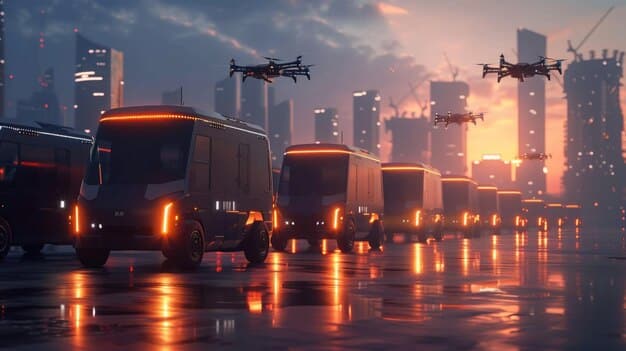
Anticipated Trends and Growth Areas
Looking ahead, several trends are poised to shape the future of logistics tech:
- Hyper-Personalization of Delivery: Leveraging data to offer increasingly tailored delivery options and experiences to consumers.
- Increased Automation Beyond Warehouses: Expanding autonomous operations to include line-haul trucking and even drone deliveries in specific niches.
- Focus on Resilience and Risk Management: Utilizing AI to build more robust supply chains that can withstand disruptions like pandemics or natural disasters.
- Cross-Industry Collaboration: Greater partnerships between logistics tech companies, freight carriers, retailers, and manufacturers to create integrated ecosystems.
The push for sustainability will also continue to drive innovation, with more emphasis on electrification, carbon offsetting, and circular economy models within logistics. As the market matures, consolidation among startups is likely, leading to more comprehensive, end-to-end solutions. The overarching goal will be to create a logistics network that is not only efficient and cost-effective but also intelligent, adaptable, and environmentally responsible, capable of meeting the dynamic demands of a future-proof economy. This complex interplay of technological advancements and market forces will continually redefine the landscape, presenting both challenges and unparalleled opportunities for those poised to innovate and adapt. The evolution is ongoing, promising an even more interconnected and optimized future for the movement of goods.
| Key Area | Brief Description |
|---|---|
| 📊 Route Optimization | Leveraging AI and data to find the most efficient delivery paths, reducing costs and transit times for last-mile delivery. |
| 🌐 Supply Chain Visibility | Real-time tracking and data integration across the supply chain using IoT and cloud platforms for enhanced transparency. |
| 🤖 Warehouse Automation | Robotics and automated systems improving speed, accuracy, and safety in logistics warehouses through efficient material handling. |
| 🌿 Green Logistics | Developing sustainable solutions for logistics, focusing on reduced emissions, efficient resource use, and eco-friendly practices. |
Frequently Asked Questions About Logistics Tech
▼
Logistics tech refers to the application of technology to optimize and streamline various aspects of the supply chain and delivery processes. This includes software, hardware, and innovative solutions focused on areas like route optimization, warehouse automation, inventory management, and real-time tracking to enhance efficiency and reduce costs.
▼
Logistics tech optimizes delivery routes using advanced algorithms, AI, and real-time data. These systems analyze factors such as traffic, weather, delivery windows, and vehicle capacity to calculate the most efficient paths. This leads to reduced fuel consumption, faster delivery times, and improved overall productivity for businesses.
▼
Robotics play a significant role in modern logistics tech, particularly in warehouse automation. Autonomous mobile robots (AMRs), robotic arms, and automated storage and retrieval systems (AS/RS) are used for tasks like picking, packing, sorting, and transporting goods, dramatically increasing speed, accuracy, and safety while reducing labor costs.
▼
Logistics tech improves supply chain visibility by integrating data from various points in the supply chain into a unified platform. Technologies like IoT sensors, blockchain, and cloud-based systems provide real-time tracking of goods, inventory levels, and shipment progress, allowing businesses to monitor operations and anticipate disruptions proactively.
▼
Green logistics is crucial for US businesses due to increasing environmental concerns, consumer demand for sustainable practices, and regulatory pressures. Logistics tech helps achieve this by optimizing routes for emissions reduction, facilitating fleet electrification, promoting sustainable packaging, and improving waste management, thereby reducing the environmental impact of operations.
Conclusion
The transformative power of logistics technology on US businesses is undeniable. From revolutionizing the intricate last-mile delivery to enhancing comprehensive supply chain visibility and driving sustainability, these innovations are reshaping how goods move across the nation. While challenges in adoption and infrastructure remain, the continuous evolution of AI, robotics, and data analytics promises an even more efficient, resilient, and environmentally conscious future for the American logistics sector. Businesses that embrace these advancements will undoubtedly gain a significant competitive edge in an increasingly demanding market.
